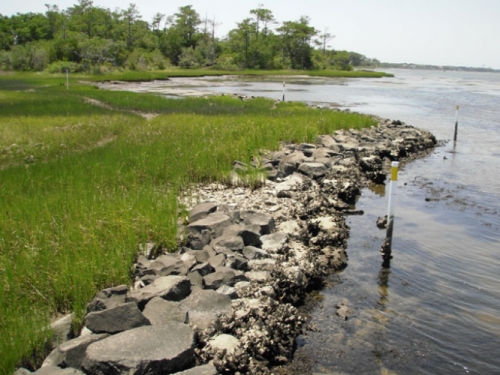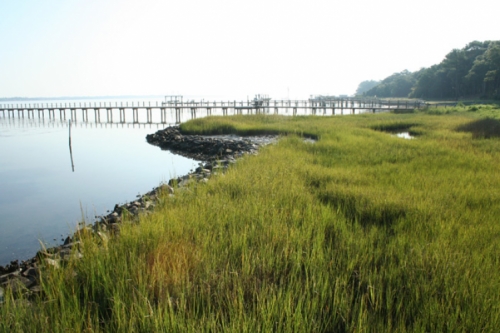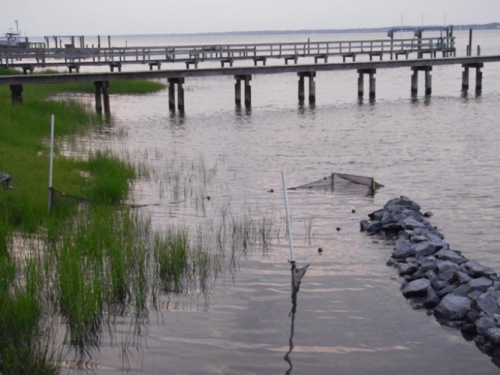In 2010, Rachel Gittman spent her summer days knee-deep in the cool waters of North Carolina’s channels and sounds, enjoying the views, the sea breezes, and the sun, while other graduate students toiled in dimly lit labs. She wasn’t on vacation. She was checking North Carolina’s fish habitats. We humans had built rocky walls around some salt marshes that many young fish call home. Gittman was curious to see if fish could wriggle their way through or over the man-made barriers. If not, we humans might have fewer fishes to fry.
For centuries, North Carolina’s tidal salt marshes have acted as buffers from storms and erosion while serving as habitats for fish and crustaceans. But the coast is an ever-changing place. For instance, rising sea levels have caused some salt marshes to slowly migrate inland. That’s not a problem in unpopulated areas. But when marshes creep toward valuable waterfront property, residents get antsy. Some homeowners have built walls on the edges of their properties to keep the marshes and erosion at bay lest their backyards turn into wetlands or their homes fall into the sea.
The problem with building bulkheads is that salt marshes become stuck between the ocean and a hard place. As sea levels rise or erosion does its thing, marshes can’t climb walls. They shrink and may someday even disappear, imperiling the habitats that 90 percent of North Carolina’s saltwater fish and shellfish need for food and nurseries.
In some areas a solution has been put into effect. It’s a different kind of wall, a layer of rocks—a lot of rocks—between the grassy, nutrient-rich marshes and the sea.
Ten years ago, the NC Division of Coastal Management permitted landowners to build low-lying rocky banks called sills at the seaside edges of marshes. The idea was that the sills would limit coastal erosion while saving salt marshes and people’s back yards. No one was certain it would work. And no one asked the fish if they were okay with this arrangement. So Gittman decided to check in with them.
From June to October 2010, Gittman surveyed twenty-five salt marshes from Nags Head in the north to Cape Fear in the south. “The idea was to see if fish could get back there, behind the sill, and access the marsh,” she says.
Small fish like structures, especially rocky shoals and oyster reefs, because large predators struggle to penetrate them. Gittman wanted to see if the fish minded man-made structures buffering their part-time homes. According to her preliminary findings, fish were still able to get into the grassy areas of the marsh. “Most of what I caught were small fishes,” she says. “Occasionally I’d catch a large predator, who clearly came in to feed.”
To quantify her initial observations, Gittman focused on three salt marshes similar in nature along Bogue Sound near Morehead City. Each month, at high tide and at night, Gittman would cast a large net into the flooded grasses behind the sills. At low tide she’d remove the net and see what she had caught. Gittman also cast nets on the ocean side of the sills during low tide, and she surveyed marshes without sills. Consistently, she found more fish and other marine animals on the marsh side of the sill than on the seaward side or in marshes without sills. “Actually, there was a higher diversity of fish behind the sill,” she says. “I think that had to do with the added structure.”
Gittman cautions not to read too much into her findings. For one, she recognizes that it would be best to survey a marsh without a sill and then survey exactly the same area after a sill had been built. She’s doing that now, monitoring salt marshes where landowners plan to build rocky barriers. “I’ll go back after the sills are built to see if the structures are causing some of the differences I’ve seen at other sites,” she says. “Until we look before and after, we can’t really tie everything together.”
At the very least, Gittman’s early work has shown that some sills in North Carolina are fish-friendly. And sills also seem to be adequate alternatives to bulkheads, so far.
Gittman says that when the state first permitted sills, some people thought that sediment that washes into marshes during high tide would get trapped behind the sills, creating high-marsh habitats inaccessible to fish. It’s been about ten years since the first sills were built, Gittman says, and so far so good. “Sills are excellent at trapping silty sediment,” she says. “The sediment settles, and then plants stabilize it.” But the marshes she checked don’t seem to be morphing into highlands. The possibility persists, though, especially if future sills are built incorrectly, she says. As of now the silled marshes are adding some protection against erosion. When the sills capture silt, they allow marshes to keep up with the natural erosion rates, Gittman says.
There’s just one caveat, she says: “We haven’t had a good hurricane in the last ten years or so.”
Rachel Gittman is a doctoral student in the Curriculum for the Environment and Ecology in the College of Arts and Sciences. She received funding from the NC Division of Marine Fisheries.






